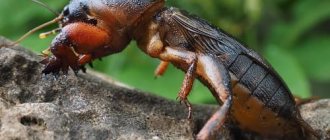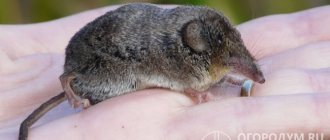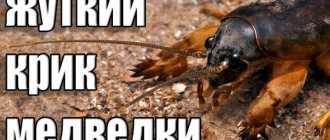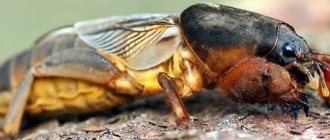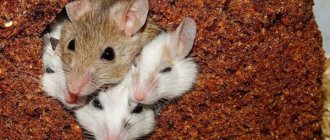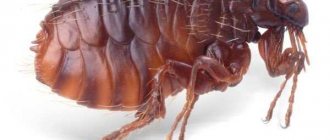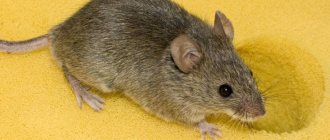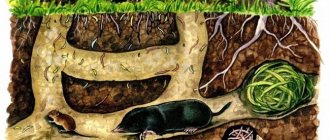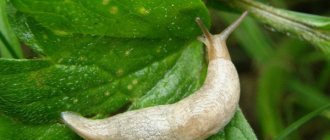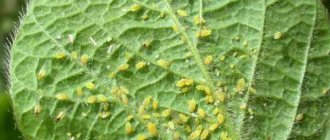Fighting a mole cricket is not an easy task. To destroy this insect, you need to arm yourself with effective means. We will tell you which chemical and organic preparations are most effective against mole crickets.
Surely every gardener knows what a mole cricket looks like. This rather large dark brown insect has an abdomen 3 times larger than its head. At the same time, at the end of the abdomen there are 2 processes about 1 cm long, and on the head there are eyes, mustaches, tentacles and the oral cavity. The mole cricket also has 2 pairs of limbs and long scaly wings.
This is what a mole cricket and its larvae look like
This insect rarely comes to the surface. But even if you notice it, you are unlikely to be able to catch it with your bare hands: the mole cricket flies well over long distances, swims and quickly digs holes. The pest lives mainly underground, chews through the roots and root crops of garden crops, and destroys seeds.
The presence of a mole cricket is indicated by small holes in the beds and loose mounds of soil that appear in the places where the insect moves.
The moves made by the mole cricket are clearly visible after the rain.
What is a bear?
The common mole cricket is an insect found in the territory from the Scandinavian countries to North Africa. Quite large, reaching a length of up to 10 cm or even more. The body (cephalothorax) of the beetle is covered with a strong shell, which a person cannot crush without effort.
A reliable, strong shell serves as protection, into which, in case of danger, it retracts the upper body and head. Strong shovel-shaped claws, like those of a mole, help to quickly break through tunnels - passages. The mole cricket has well-developed jaws, with which it copes well with roots and roots, gnawing them.
Medvedka is also called the underground knight, since she spends most of her time underground. It rises to the surface mainly at night and goes to a depth of up to two meters for the winter.
Harm
The main danger is the destruction of the crop. Having appeared on the site in single copies, the mole cricket reproduces very quickly. Numerous hordes quickly destroy the harvest of root crops: potatoes, radishes, radishes, carrots, and beets. They do not disdain the young roots of planted seedlings of tomatoes, cabbage, onions and cucumbers lying on the surface of the ground.
It causes great harm to shrubs, eating up plant roots, as well as bulbous plants (tulips, lilies, gladioli, etc.), strawberries, watermelons, melons. The voracious bug feeds not only on plant foods; it also uses earthworms, larvae, and small insects.
It is easy to notice the appearance of insects in the garden. Making their tunnels underground, mounds of earth are visible on the surface of the soil. The pest is especially active in the spring, when the earth warms up. That is why gardeners perceive this insect as their worst enemy. You will have to put in a lot of effort and time to get rid of it forever.
Reasons for appearing in the garden
The invasion of cabbage weeds in the garden can be facilitated by adding fresh organic fertilizer to the soil, regardless of whether the product was applied to increase the fertility of the soil on your own plot or on a neighboring one. Mole crickets can overwinter in any manure, although some gardeners claim that fresh chicken manure is used specifically to get rid of the pest. The second reason for the appearance of cabbage mushrooms can be waterlogged mulched soils, as well as lands where groundwater is located near the surface layer.
How to detect presence
Before destroying a harmful insect, it is necessary to accurately determine its presence in the garden. This can be done based on characteristic signs that are visible upon careful inspection of the territory.
The main signs of the appearance of a mole cricket:
- a constant increase in the number of wilted plants;
- small mounds on the beds;
- small holes in the ground;
- eggs or larvae (can be found while digging up soil or planting plants);
- characteristic sound at night (resembles the chirping of a grasshopper).
How are insects dangerous for plants?
Harm in the garden from the mole cricket is manifested in the death of all cultivated plants encountered along its path. Moving through underground passages, the pest gnaws on roots, tubers, foliage and seeds of various crops. The insect can indiscriminately damage both adult plantings and young seedlings. But this parasite is not interested in weeds.
Most often, vegetables such as cucumbers, tomatoes, peppers, eggplants, cabbage, legumes, cereals, strawberries and other berries, as well as flower perennials, suffer from mole crickets. The parasite's favorite food is the pulp of root vegetables - potatoes, radishes, carrots and beets.
Due to the suitable optimal conditions for life, the mole cricket has chosen greenhouses and hotbeds. Damaged plants die quickly before reaching maturity.
Lures
To attract beetles, aromatic compounds and food additives are used. Baits are prepared on the basis of mashed potatoes, vegetable oil, and various cereals. To protect grain crops and annual herbaceous plants, Triathlon is used, a three-component post-emergence herbicide with systemic action. If an area is heavily infested with mole crickets, ticks and whiteflies, use the contact acaricide “Sturm”, which destroys parasitic insects en masse and at all stages of development.
Chemical control of mole crickets: effective means
The most effective way to remove mole crickets from the territory of the dacha is to use various chemicals. These substances will quickly destroy most of the uninvited guests and will not cause harm to garden crops.
"Medvetox"
You can drive out a mole cricket with this drug in just a few hours. In this case, the effect of treating the beds will be noticeable over the next two weeks. The product is red granules that do not harm beneficial insects (for example, earthworms) and do not affect soil fertility.
Mode of application:
- Using any gardening tool, make grooves in the beds no more than 5 cm deep.
- Granules of the substance are placed in them.
- The product is instilled.
"Antimedvedka"
With the help of this chemical it is easy to poison not only the mole cricket, but also many other underground inhabitants. The product is produced in the form of granules or microgranules, packaged in convenient bags. One package of the substance will be enough to protect an area of 15 acres.
Algorithm of actions:
- When sowing or planting garden crops, leave a little space between the rows.
- In these free areas, grooves are made with a shovel.
- “Antimedvedka” is poured into them and buried.
"Medvecid"
This substance is produced in bags of 100 g. This amount of poison is enough to destroy all cabbage mushrooms on an area of 10 acres. The method of using Medvecid is similar to that used for Medvetox.
Important Features:
- the depth of the grooves should not exceed 3 cm;
- the optimal distance between chemical deposits is a meter;
- 5 to 10 granules should be placed in one groove.
Using this drug, you can quickly get rid of mole crickets on the site and prevent its appearance in the future. "Phenaxin Plus" is made in the form of granules that have a specific taste and aroma. Having swallowed the poison, the beetle quickly dies.
Procedure:
- Granules of the substance are placed in pre-prepared grooves.
- Plant seedlings and sow seeds.
- As soon as the first shoots appear, the grooves are torn and refilled with granules.
"Rembek"
This insecticide has a pungent odor that attracts the attention of mole crickets. After swallowing the poison, it immediately begins to act, which leads to the death of the creature. One package of the drug is enough to treat an area of 15 acres.
“Rembek” is laid out in open passages and found holes. At the same time, they try not to destroy the tunnels dug by pests.
"Boverin"
If there is a mole cricket in your garden, then Boverin will help you deal with it. The product contains spores of the muscardine fungus. When a pest gets on the body, they quickly germinate and penetrate inside. This leads to the death of the creature.
You need to treat your garden with Boverin once every two weeks. In this case, the substance must be applied to the soil, trying to prevent it from getting on the seedlings.
"Thunder"
This poison is available in granular form. It contains diazinon (the active ingredient), as well as several attractants that force the insect to feast on the poisonous bait. Once in the body of a mole cricket, “Thunder” paralyzes it, which leads to death.
The product is applied in the traditional way, which involves burying granules in the ground.
"Grizzly"
"Grizzly" is an improved analogue of "Thunder". It contains the same components, but in different proportions. Thanks to this, the product allows you to get rid of mole crickets in the garden and forget about its existence forever.
To quickly expel mole crickets from your summer cottage, you should use Banakol. This drug, which has a paralytic effect, is produced in powder form.
Mode of application:
- The powder is diluted with water in the proportions specified by the manufacturer.
- The resulting suspension is mixed with grain bait. For maximum effect, you need to take 10 g of the substance for every kilogram of grain.
- Most of the finished product is buried in the ground, and the remainder is distributed over the surface.
"Beargon"
This granular substance exterminates not only mole crickets, but also many other pests (for example, wireworms or ants). The main advantage of the product is its double action. Thanks to this, the insect will die not only after eating Medvegon granules, but also upon contact with them. The product is used sparingly, so 20 g is enough to treat an area of 10 acres.
"Aktara 25 WG"
"Aktara" is a modern insecticide characterized by instant action and high efficiency. After treating the area with the drug, 15 minutes is enough for most of the insects to become poisoned. Other advantages include a long period of protection for the garden (up to two months) and a wide spectrum of action.
Despite its effectiveness, Aktara 25 WG does not harm crops. You need to spray the beds with it before planting any vegetables. Before use, be sure to dilute the product package in 10 liters of water.
"Prestige 290 FS"
This German insecticide has systemic and contact action. Its characteristics are similar to Aktara. The difference lies in the need to apply the product two weeks before planting the plants in the ground.
"Nemabakt"
This effective biological agent acts on mole cricket larvae. It contains bacteria that penetrate inside the creature and multiply quickly there. As the microorganisms grow, they eat their prey.
Protective rings and barriers
One of the most effective methods involves installing a protective fence. It is made from a plastic bottle, the bottom and neck of which are cut off. The remaining part of the container is deepened into the ground around the shoots. The mole cricket will not be able to chew through the plastic ring or crawl under it.
Plants that repel mole crickets:
Kapusyanka does not like all smells. Gardeners often use this feature to protect their crops.
Marigold
These beautiful and pleasantly smelling flowers are an effective mole cricket repeller. The aroma coming from the buds makes them fly around the garden and look for places with more favorable conditions.
To completely protect your garden plot from harmful insects, it is enough to plant marigolds along its entire perimeter.
Chrysanthemums
To save crops from mole crickets, it is not necessary to poison or kill it. It is enough to take several dozen chrysanthemum branches and dig them into the ground. The smell will repel beetles and protect the planted plants.
Coriander
The real way to drive mole crickets out of the garden involves planting coriander. It will not only protect the area, but can also be used in cooking. The roots and seeds of coriander are used as a seasoning, and the leaves are used to decorate various dishes.
Garlic
If you do not want to poison mole crickets with chemicals, then you will have to save the seedlings using alternative methods. One of the most effective is considered to be planting garlic. Its smell repels many beetles, preventing them from spoiling the crops. If it is not possible to plant garlic, then you can lay out its husks in various parts of the garden.
Onion
It does not kill mole crickets, but effectively copes with their invasion. The principle of action of onions is the same as that of garlic. The gardener can independently choose one of two options:
- planting onions;
- laying out the husks.
Agrotechnical techniques
Agrotechnical practices include:
- autumn plowing (deep digging of the site in the fall);
- spring digging;
- removal of weeds;
- regular inspection of the site.
In early spring, in weed-free beds prudently dug up in the fall, the passages of cabbage grasses are very clearly visible. During this period, it is easy to collect pests manually; it is enough to dig to a depth of 25–30 cm in the immediate vicinity of the entrance hole. The chance of getting caught by an insect is quite high. But in untreated areas it is almost impossible to detect and get rid of mole crickets.
Security measures
Potent synthetic compounds designed to combat harmful insects require compliance with certain safety rules.
When carrying out disinfestation:
- Wear a suit made of thick rubberized material.
- To protect the eyes and respiratory tract, use sealed goggles and a gauze bandage or respirator.
- Pesticides dissolved in organic liquids can cause burns and allergic reactions upon contact with the skin. To work with them, wear closed overalls.
- Solutions are prepared in the fresh air or in a well-ventilated area.
- When treating crops with such potent chemicals as Fastak, take breaks every half hour.
At the end of the disinfestation procedure, take a warm shower. Chemical protective equipment is not brought into residential premises.
Folk remedies
Kerosene
Kerosene is used to use its smell to drive away harmful insects from vegetable crops. Kerosene in an amount of 50-70 ml is mixed with 1 kg of sand and 2-3 shovels of earth. The mixture is added to the planting holes and spread between the plants.
Soapy water
This solution is used to fill the discovered holes and passages of pests. Sometimes it is enough to pour only 2-3 liters of water into a hole, with washing powder (the cheapest) dissolved in it, to drive an adult insect out of the ground. In this case, you need to prepare in advance and put on gloves on your hands, because you will have to catch the pest.
Eggshell
The shell helps protect the seedlings from being eaten by mole crickets. Crushed shells, soaked in fragrant vegetable oil, are laid out to a depth of 3 cm around the plant at the time of planting in the hole. The insect, crawling toward the root of the plant following the scent, encounters the bait, swallows it and dies.
Karbafos
Used for poisonous baits made from boiled bran or cereals. For example, for 1 kg of boiled oats, use 50 g of unrefined cold-pressed sunflower oil and 50 g of karbafos. Mix everything thoroughly. The bait is laid out in shallow holes around the garden, which are covered with earth so that birds and animals cannot eat them and die along with the mole cricket.
Trap
The trap can be a champagne bottle, dug into the ground at an angle of 20-30° with a depth of 2-3 cm. A small amount of either beer, wine, or sweet bait is poured into the bottle. The neck of the bottle must be covered with one layer of gauze - insects gnaw through the fabric and fall to the bottom of the bottle, from which the owner of the garden will subsequently remove it.
Protective rings
Some mole crickets bypass protective rings made from cut plastic bottles quite easily, penetrating to the roots of the plants underneath. But still, many gardeners manage to save plants from the pest by placing plastic rings up to 7 cm high on the seedlings at the time of planting in the ground. The main thing that needs to be done is to bury the ring into the soil by 3-4 cm.
Mechanical removal
You can protect seedlings from mole crickets using mechanical methods. It is best to apply them in the spring, before the immediate planting of cultivated plants, or in late autumn. The second option is considered more effective, as it allows you to destroy most of the beetles.
Work order:
- In the middle or end of November, the garden is dug up.
- The upturned layers of earth will open nests in which mole crickets settle for the winter. Frosty air will quickly kill heat-loving creatures.
- After this, holes about 50 cm deep are dug in several places.
- Fresh manure is placed in them.
- The holes are buried and their location on the site is marked.
- The manure will attract the attention of large mole crickets that will want to spend the winter in it.
- After 1-2 days, they dig up the foul-smelling bait and scatter it around the garden.
- Creatures killed by the cold are collected manually.
Advice! If you add straw to the manure, you can attract many more mole crickets.
How to get rid of mole crickets forever using ammonia
The smell of ammonia repels cabbage grass. Ammonia (10% ammonia, 3-4 tsp) is diluted in 10 liters of water. In order not to harm the plants, this concentration will be sufficient. Young seedlings are watered with the mixture at the rate of 0.5 liters per plant. The smell of the drug disappears quickly, so this procedure is repeated once a week. If the leaves on the plants turn yellow, stop watering with the product. In order not to harm the seedlings, pieces of fabric are soaked in ammonia and laid out between the plants.
Appearance of the pest
The mole cricket is a large garden pest, so it will be difficult to confuse it with any other creature. You can recognize this representative of the fauna by 10 features of its appearance.
These include:
- size 4–5 cm;
- on the small head of the mole cricket there are antennae, eyes, mouth and tentacles;
- abdomen approximately 3 times longer than cephalothorax;
- at the end of the body there are paired processes one cm long;
- the forelimbs of the mole crickets are turned inward;
- there are 4–5 sharp spines on the hind legs;
- the length of the fine-scaled wings exceeds the size of the body;
- the limbs are colored brown, and all other parts of the body are brown.
Interesting! Mole crickets can not only fly well, but also swim. Read the article here for lifestyle and ways to deal with mole crickets.
Setting up traps
To exterminate insects, traps are built in gardens and garden plots, luring mole crickets with honey, beer, and fermented jam. The basis of the traps are containers (plastic bottles, glass or tin cans) buried in depressions in the soil. A little beer or other bait is poured into them and covered with a board or piece of tarpaulin on top.
Holes are dug in places where the pest is expected to live, and traps are checked every 10-15 days.
Description
The garden mole cricket is a large insect, reaching a length of 5 cm, although some gardeners claim that they have met individuals up to 15 cm long. What does a mole cricket look like? Its soft abdomen is spindle-shaped and about a centimeter in diameter, three times longer than the cephalothorax. At the end of the dark brown abdomen there are cerci - paired thread-like appendages up to 1 cm long. The chest is protected by a hard shell, under which the mole cricket can partially hide its head. The insect's eyes are large and complex; there are also a pair of tentacles on the head, long antennae and very strong jaws. The front pair of mole cricket limbs with claws are designed so that it is convenient for her to dig the ground.
Mole crickets have wings, but in order for their muscles to work, they need warm air, so mole crickets do not fly often, but they swim quite quickly. At night, especially during the mating season, mole crickets sing - they emit powerful trills, chirp and chirp, using the friction of their wings for this.
Mole crickets make a nest at a shallow depth, approximately 6x6 cm in size, and lay up to five hundred dark yellow eggs with a diameter of 4-5 mm in it, from which larvae emerge about two weeks later. The larva of the mole cricket beetle has a body shape similar to an adult insect, but it is not dark brown, but gray. The mole cricket larva grows for several years.
We will tell you what methods exist to combat mole crickets, how to fight mole crickets in the garden using folk remedies, and whether it is possible to get rid of mole crickets forever.
Preventative treatment
It is much easier to prevent a mole cricket from entering the area than to fight it later. A mole cricket will not appear in the garden if you dig up the soil every fall to the depth of a spade bayonet - the larvae and adults will die from the cold. A preventive measure against the appearance of mole crickets in the garden can be a refusal to use manure as a fertilizer for plants, since it is with it that the pest most often enters the site. You can replace manure with chicken droppings.
Mole crickets love well-warmed soil, and to lower its temperature, mulch the surface of the area with light material - straw or sawdust.
Garlic, cilantro, coriander, parsley, marigolds, calendula or chrysanthemums planted between rows prevent the appearance of mole crickets. The pest does not like pine needles and fresh alder leaves, which are buried in the grooves along the perimeter of the beds. They say that a good mole cricket repeller is mothballs poured into deep furrows around the beds.
You can scare off mole crickets in a greenhouse using a mixture of sand and kerosene at the rate of 1 kg of sand and 50-70 ml of kerosene per m² of bed: spill the sand with kerosene, mix it thoroughly, throw a few shovels of dry earth to the sand and mix everything again. When planting seedlings, scatter this soil mixture over the surface of the beds and mix it evenly with the top layer of soil.
Reliable protection against mole crickets is provided by treating the root system of seedlings with a suspension of Aktara or Prestige. And those who are not bothered by the smell of rotten fish can use this method of repelling the pest: when planting seedlings in the ground, place small fresh fish in each hole. When the fish begins to rot, the smell of decomposition scares away the mole cricket and it leaves. True, she can go not far - to the next garden bed.
Plants with an unbranched root system can be saved from mole crickets by digging a cut plastic bottle into the hole and planting a seedling in it. This “armor” prevents the pest from getting to the roots and stems of the plant.
Well, it would be nice to enlist the support of the mole cricket’s biological enemies, which are birds (storks, rooks, crows, starlings) and insectivorous animals - shrews, hedgehogs, moles, lizards, ants, scolopendras or ground beetles. If you attract the most harmless of them to your site, you may never know what a mole cricket looks like.
Source
